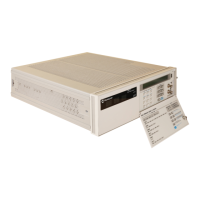Chapter 4 Remote Operation and Programming
Command Types
50 Operating and Programming Manual
Command Types
There are two types of 5071A program commands: IEEE 488.2 Common and
SCPI. The SCPI commands control instrument functions while the IEEE 488.2
Common commands control and manage communications between the 5071A
and a terminal or personal computer.
Common Command Format
The IEEE 488.2 standard defines the Common commands that perform functions
like reset, self-test, status byte query, and identification. Common commands are
four or five characters in length, always begin with the asterisk (*) character, and
may include one or more parameters. The command keyword is separated from
the first parameter by a space character. Some examples of common commands
are:
*RST
*ESR?
*IDN?
SCPI Command and Query Format
SCPI commands perform functions like instrument setup, synchronization,
adjusting epoch and reporting instrument-specific operating parameters. A
subsystem command structure is a hierarchical structure that usually consists of a
top level (or root) command, one or more lower-level commands, and their
parameters. The following example shows part of a typical subsystem for an
issued command and its associated query (?):
DIAGnostic:LOG:VERBosity <DISable|TERSe|VERBose|SERVice>
:VERBosity? DIS|TERS|VERB|SERV
DIAGnostic is the root command with :LOG and :VERBosity (?) the second
level commands with command and response parameters.
Command Separator
A colon (:) always separates one command from the next lower-level
command as shown here: DIAGnostic:CURRent:CFIeld?

